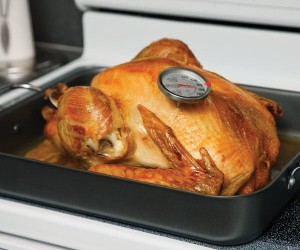Maybe you’re worried about the upcoming Thanksgiving and Christmas holiday eating that will be taking place. With an eye on the scale, you’re wondering how you’ll fare with all of the home-cooked meals and desserts that seem never-ending.
The health-conscious will boast about their “clean eating” habits, but you can still enjoy the holidays while eating the foods you normally do.
But healthy eating isn’t limited to just what you consume. It starts with food handling, storage and preparation.
Proper food handling and storage
Not sure how long to keep food in your pantry, fridge or freezer? This infographic summarizes the shelf life of many of the main foods you cook and serve. Beyond that, there are many precautions that cooks need to take in the kitchen.
The USDA says that four basics of holiday food safety tips are: clean, separate, cook and chill.
Clean
Always wash your hands for at least 20 seconds with warm water and soap before and after handling food, especially raw eggs, meat and seafood. Use hot soapy water to wash any surfaces that raw food has touched, like countertops, utensils, dishes and cutting boards.
Rinse all fruits and vegetables with cool running water before storing and using it. Also, use a small brush to remove debris from fruit and vegetables. Do not rinse raw meats and poultry before storing or using. Rising will spread any bacteria that are present on the product.
Separate
Keep raw foods away from foods that won’t be cooked. Also, keep raw foods away from kitchen utensils. Raw eggs, meat, poultry and seafood should be stored separately in the refrigerator, too.
Use separate cutting boards for different products. One cutting board could be used for meat products, while a second cutting board could be used for fruits and vegetables. Also, use a clean plate for cooked meat or any other food that is ready to eat. Don’t reuse a plate that held raw foods on it.
Cook
Always use a food thermometer to check the internal temperature of meats before serving. When reheating gravies, sauces or soups, bring the food to a rolling boil before serving.
Eggs, like meat, must be cooked a certain way to ensure safety. Make sure that the yolk and the white are both firm before serving.
As tempting as it is, don’t eat raw cookie dough. Uncooked dough contains raw eggs.
Chill
Your refrigerator should be set at no higher than 40 degrees Fahrenheit. Your freezer should be set at 0 degrees F. Always refrigerate leftovers within two hours, and eat them within several days.
Don’t thaw frozen foods at room temperature. Use the refrigerator, microwave or run the food under cold water to defrost. If you use the cold water method, immediately cook the food in the microwave. Allow enough time to properly thaw food. For example, turkey needs a specific amount of time to thaw based on its weight.
Minimum cooking temperatures
It takes more than just looking at meat to know if it is completely cooked. Meat can still be pink but considered cooked based on minimum cooking temperatures.

In order to avoid food-borne illnesses, safe minimum cooking temperatures are recommended for meat:
- Beef, veal and lamb 140 degrees F
- Pork and ham 145 degrees F
- Poultry (chicken, turkey) 165 degrees F
Even leftovers and casseroles should be at least 165 degrees F before they are eaten.
The minimum cooking temperature recommended for leftovers and casseroles is 165 degrees F.
Use a food thermometer to determine that your meat and other dishes have safe internal temperatures.
Healthy holiday eating
It’s easy to overeat during the holiday season with all of your favorite comfort foods and sweets in abundance, but moderation now means less struggle later when you’re trying to get in shape before your summer vacation.
OSU Extension Chow Line has some great tips for staying healthy during the holiday season, and moderation is one of them. Self control is key. Limit yourself to a small amount of dessert, whether that be one piece of pie or two cookies.
Self control is key. Limit yourself to a small amount of dessert, whether that be one piece of pie or two cookies. Recognize your trigger foods and find ways to distract yourself from eating them. Overall, moderation is the most important point to remember. You can still enjoy sweet potato casserole or a slice of cheesecake and maintain a proper diet.
If you’re the host of a holiday gathering, consider serving healthy alternatives to popular snacks and treats. Offering fruits and vegetables as lower calorie snacks before dinner could prevent people from overeating. Pre-cutting food requires people to limit their portion sizes.
You can offer water or low-calorie beverages instead of soda. Offering small plates may make people go back for seconds, but they’re less likely to overeat.
For more information on food safety, visit foodsafety.gov, and for more information on healthy eating, visit choosemyplate.gov.
STAY INFORMED. SIGN UP!
Up-to-date agriculture news in your inbox!











